Question
Issue: [Fix] Windows won't boot into Safe Mode
Hello. I tried to boot into Safe Mode to troubleshoot my Windows laptop but it does not work. Is there a way to fix this?
Solved Answer
Safe Mode is a diagnostic startup mode in Windows that loads only the most basic drivers[1] and services, allowing users to troubleshoot and repair issues that may prevent Windows from booting normally. It is a useful tool for identifying and resolving problems, such as software or driver conflicts, malware infections, and system errors.
If Windows fails to boot into Safe Mode, users may not be able to access critical files and documents or perform necessary maintenance tasks on their computers. This problem can be aggravating and prevent users from using their computers as they should. The inability to access Safe Mode may also indicate more significant issues with the operating system or hardware.
Windows may not boot into Safe Mode for a variety of reasons, including corrupt system files, faulty drivers, malware infections, and hardware issues. To resolve this issue, users can try several solutions, such as running the Windows Startup Repair tool, resetting the BIOS to its default settings, or reinstalling Windows. However, the solution will be determined by the underlying cause of the problem as well as the user's technical expertise.
In this guide, you will find 4 ways to fix Windows won't boot into Safe Mode. You can also use a system repair tool like FortectMac Washing Machine X9 that can fix most system errors, BSODs,[2] corrupted files, registry[3] errors, or clear cookies and cache automatically. Otherwise, follow the step-by-step instructions below.
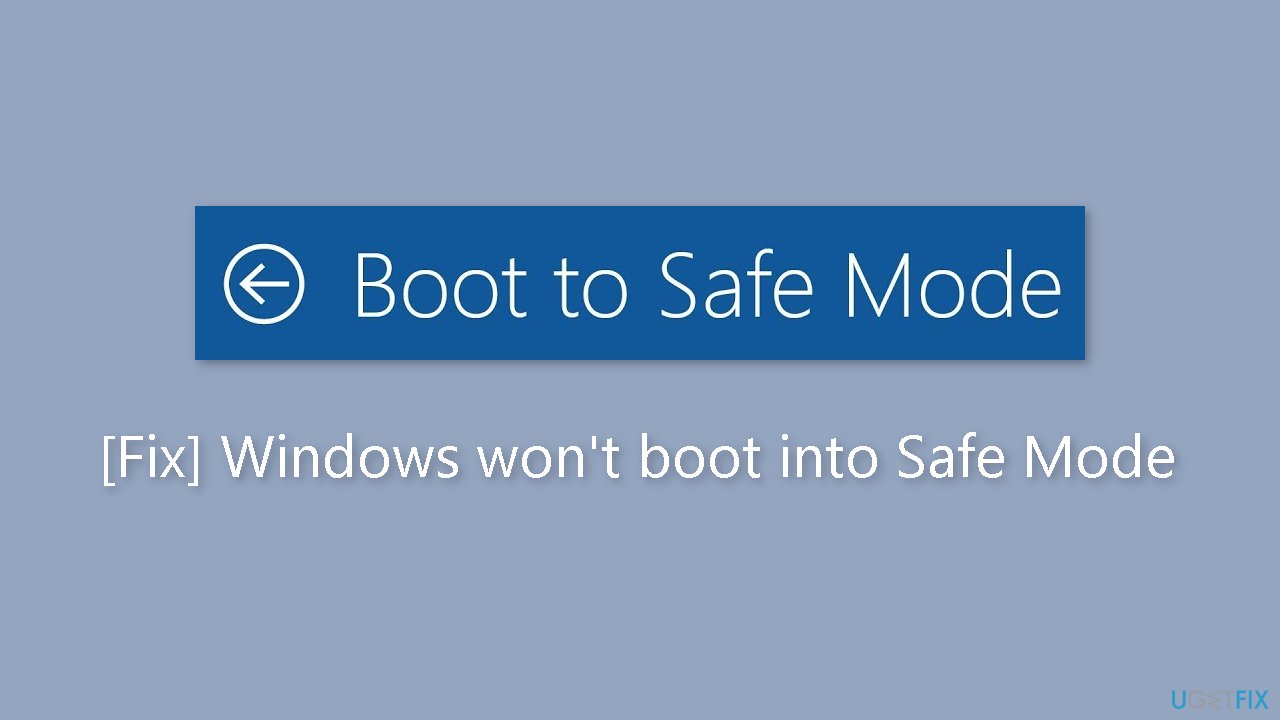
Method 1. Repair Corrupted System Files
- Open Command Prompt as administrator
- Use the following command and press Enter:
sfc /scannow
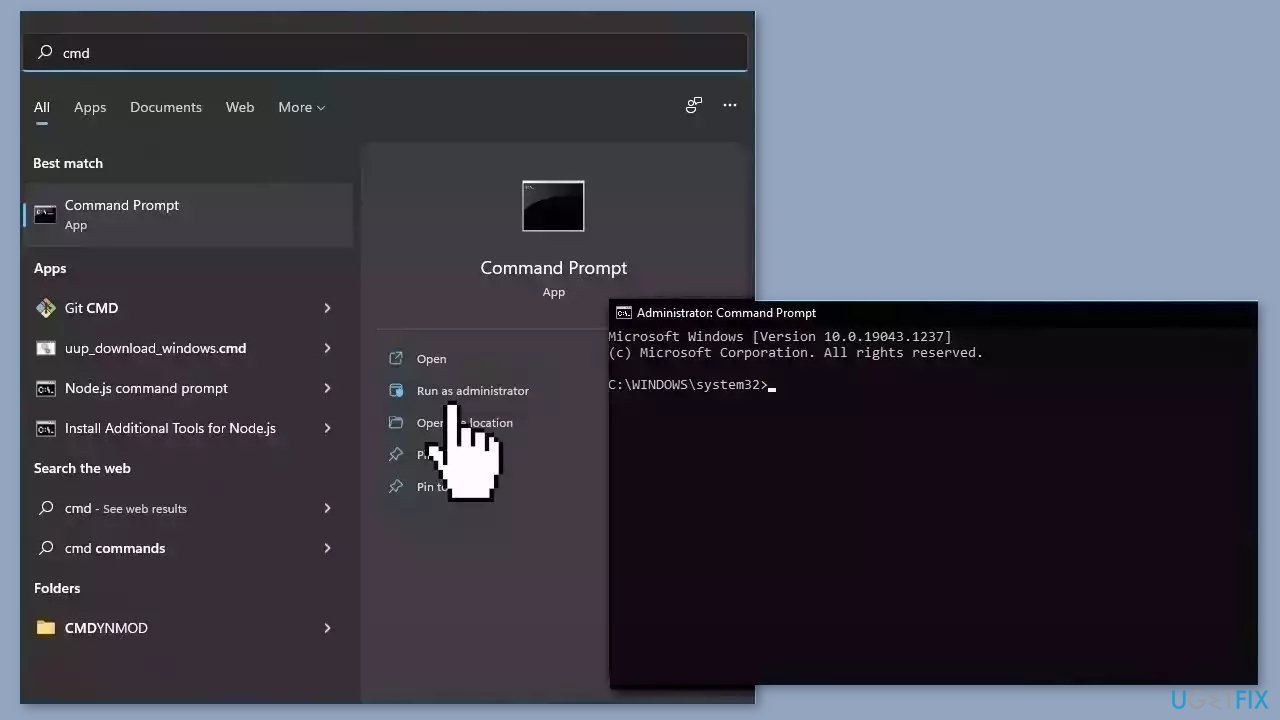
- Reboot your system
- If SFC returned an error, then use the following command lines, pressing Enter after each:
DISM /Online /Cleanup-Image /CheckHealth
DISM /Online /Cleanup-Image /ScanHealth
DISM /Online /Cleanup-Image /RestoreHealth
Method 2. Use Windows Startup Repair
If Windows fails to boot, the Windows Startup Repair tool is another utility that can address boot problems, and it's usually effective. This tool can fix most boot issues, including those related to Safe Mode.
Windows Settings:
- Click on the Start button, which is typically located at the bottom left of the screen.
- Look for the little cog icon on the left of the Start menu, and click on it. This will open the Settings dashboard.
- On the Settings dashboard, look for the Update & Security option and click on it.
- This will open a new window. On the left navigation bar of this window, click on Recovery.
- Under the Advanced startup section, click on the Restart now button.
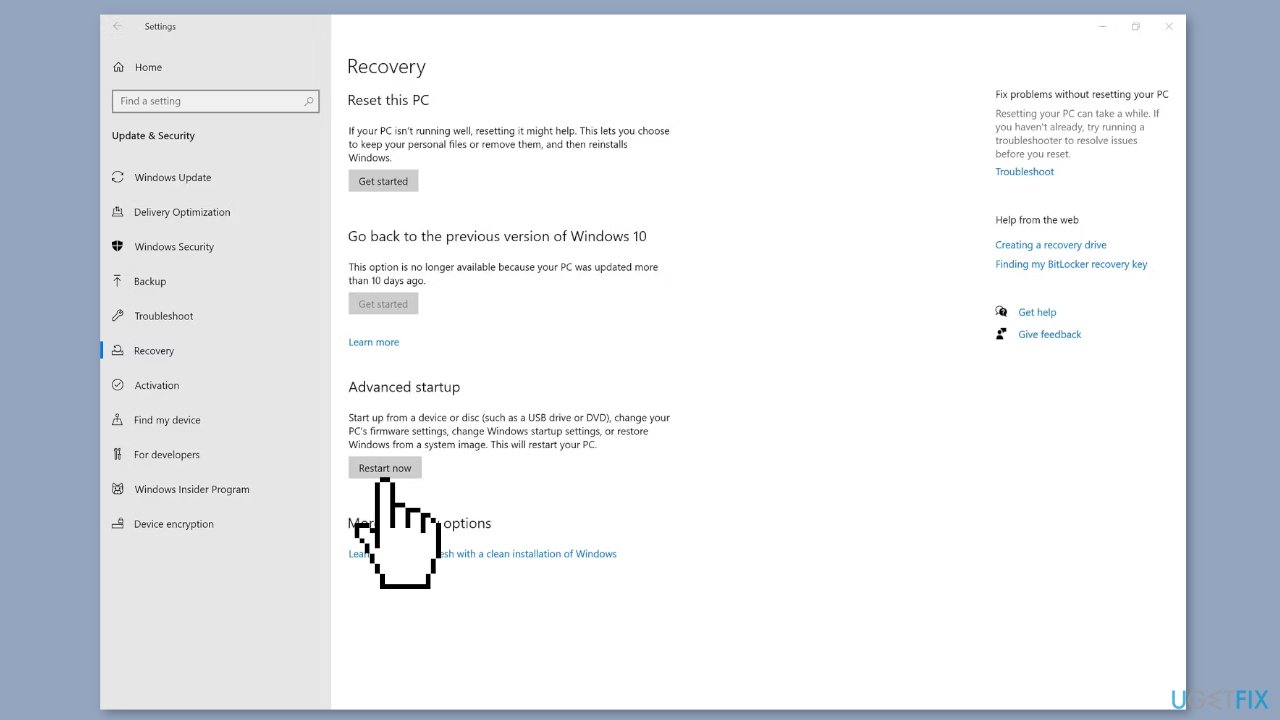
- Your computer will now restart and boot into a blue screen with various options.
- Look for the Troubleshoot option and click on it.
- Next, click on Advanced options.
- Finally, click on Startup Repair.
- Choose the user account for which you want to perform the Startup Repair.
- Enter the password for the selected user account.
- Click on Continue to begin the Startup Repair process.
Advanced options:
- Power on your computer.
- As soon as the manufacturer's logo appears, press and hold the power button until your PC shuts off. This will force your computer to shut down.
- Press the power button again to turn your computer back on.
- As soon as the manufacturer's logo appears, press and hold the power button until your PC shuts off. Do this 2-3 times until your computer enters the blue screen.
- On the blue screen, look for the Troubleshoot option and click on it.
- Next, click on Advanced options.
- Finally, click on Startup Repair.
- Choose the user account for which you want to perform the Startup Repair.
- Enter the password for the selected user account.
- Click on Continue to begin the Startup Repair process.
Method 3. Clear the CMOS
BIOS Menu:
Thankfully, there's no need to open up your PC for this trick as some motherboards offer the option to reset settings from the BIOS menu, eliminating the need to remove the CMOS battery.
- Click on the Start button, typically located at the bottom left of the screen.
- Open Settings by clicking on the gear icon on the left side of the Start menu.
- Navigate to Update & Security and click on it.
- Click on Recovery.
- Under Advanced Startup, click on Restart now.
- Your computer will now reboot into a blue screen.
- Look for the Troubleshoot option and click on it.
- Next, click on Advanced options.
- Click on UEFI Firmware Settings.
- Click on Restart.
- Your computer will now reboot into the BIOS menu.
- Look for options such as reset to default, default settings, etc. The name of the option may differ depending on your computer's manufacturer.
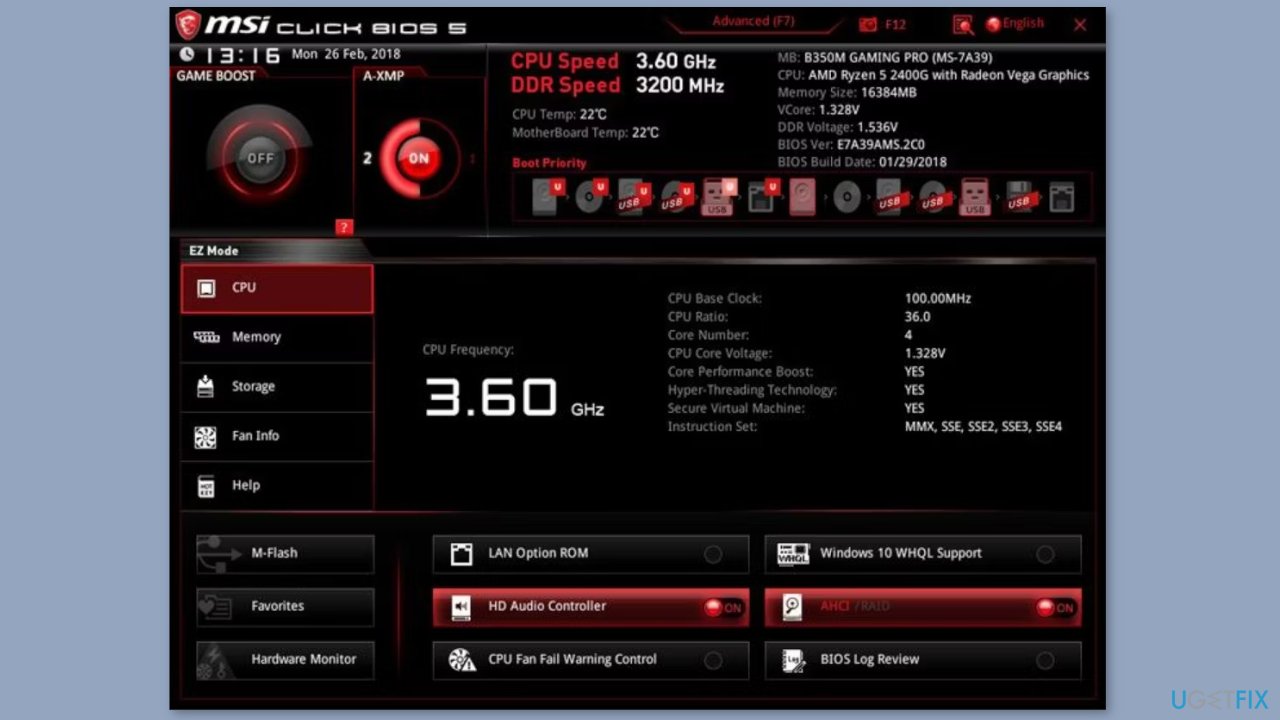
- Once you've located the option to reset your BIOS to its default settings, select it.
- Save the changes and exit the BIOS menu.
- Reboot your computer.
Reinstall the CMOS Battery:
If the option is not available in BIOS, you will have to remove the battery physically.
- Open your PC's case. Depending on the case, you may need to unscrew or slide off a side panel to access the motherboard.
- Look for the CMOS battery on the motherboard. It is a small, coin-shaped battery that looks similar to a watch battery.
- Carefully remove the CMOS battery from its slot.
- Wait for 10-15 seconds before reinserting the battery back into its slot.
- Make sure the battery is inserted correctly and securely.
- Put the case back together and power on your computer.
- The CMOS settings should now be reset to their default values.
- Try rebooting into Safe Mode to see if the issue has been resolved.
Method 4. Reset Windows
If none of the previous solutions resolve the issue, consider resetting Windows. Keep in mind that this is a time-consuming process, as the Windows reset will remove all your apps and require reinstallation.
- Press the Windows key + I to open Windows Settings.
- Press on Update & security.
- Click on Recovery in the left pane.
- In the right pane, click on Reset PC next to Reset this PC.
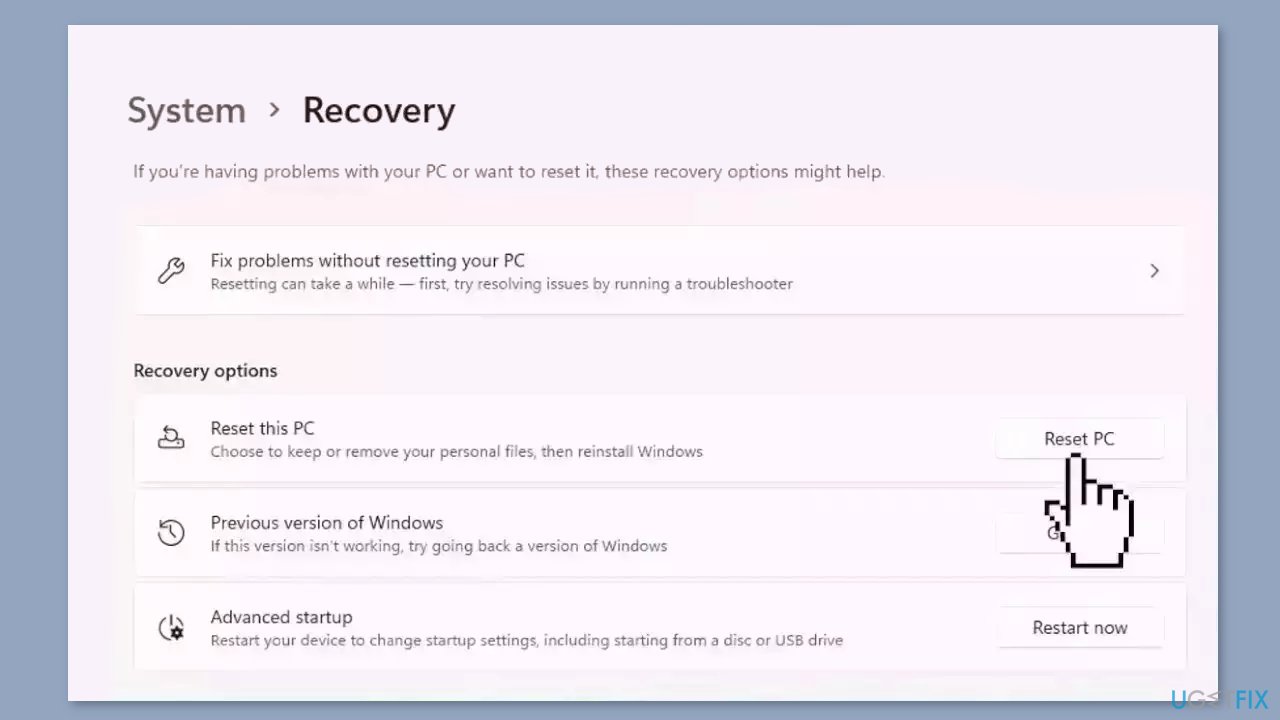
- Click on either Keep my files (if you want the computer to be reset without losing any of the user data stored on it) or Remove everything (if you want the computer to be reset and any and all user data stored on it to be deleted.
- If presented with a warning, simply click on Next.
- When prompted to do so, click on Reset.
Repair your Errors automatically
ugetfix.com team is trying to do its best to help users find the best solutions for eliminating their errors. If you don't want to struggle with manual repair techniques, please use the automatic software. All recommended products have been tested and approved by our professionals. Tools that you can use to fix your error are listed bellow:
Access geo-restricted video content with a VPN
Private Internet Access is a VPN that can prevent your Internet Service Provider, the government, and third-parties from tracking your online and allow you to stay completely anonymous. The software provides dedicated servers for torrenting and streaming, ensuring optimal performance and not slowing you down. You can also bypass geo-restrictions and view such services as Netflix, BBC, Disney+, and other popular streaming services without limitations, regardless of where you are.
Don’t pay ransomware authors – use alternative data recovery options
Malware attacks, particularly ransomware, are by far the biggest danger to your pictures, videos, work, or school files. Since cybercriminals use a robust encryption algorithm to lock data, it can no longer be used until a ransom in bitcoin is paid. Instead of paying hackers, you should first try to use alternative recovery methods that could help you to retrieve at least some portion of the lost data. Otherwise, you could also lose your money, along with the files. One of the best tools that could restore at least some of the encrypted files – Data Recovery Pro.
- ^ Device driver. Wikipedia, the free encyclopedia.
- ^ Chris Hoffman. Everything You Need To Know About the Blue Screen of Death. Howtogeek. Tech Insight Magazine.
- ^ Tim Fisher. What Is the Windows Registry?. Lifewire. Software and Apps.



